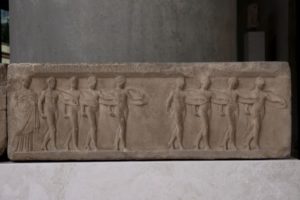Armed dances were common across the Greek world[1] and one of them – pyrrhic or pyrrhichē– seems to be the most celebrated by ancient sources.[2] The remote origin is attributed to the Spartans, who were considered a warlike people: the dance took its name from one of its famous warriors, Pyrrhichus. This dance was taught to youngsters as an exercise in preparation for war – perhaps as an initiation rite – and was characterised by the speed of movements, since it was essential in war for pursuing the enemy but also for fleeing.[3]
Dancing prepared future soldiers by providing them with key skills: coordination, pace, concentration, swiftness of movements, tenacity: those who worshipped gods with choral dances were considered to be the best in war.[4] Even Amazons danced the weapon dance and set up a choros – a collective performance. [5]
Leaping and running were surely among the dancing steps, but also ducking and dodging, as if avoiding blows and darts.[6] An aryballos – an oil container – from Corinth shows a boy performing a high jump surrounded by a text that reads “Pyrrhias prochoreumenos”.[7]
The popular dance was performed in multiple contexts: to celebrate the arrival of troops in the city[8], to mourn a fallen warrior[9], and in competitions: in Athens chorus of boys, youth and men competed separately in contests at the Panathenaia. War-dances were associated with Athena, for which she invented one to commemorate her victory after the Giants.[10]
In Attic vases war-dances are illustrated with males wearing the ephebic cloak, while female pyrrhic dancers are shown in symposia and marriage contexts. One of the most popular representations of the dance is to be found in the Akropolis Museum of Athens: a marble base – that supported at least three bronzes statues – which shows a frieze of pyrrhic dancers and an inscription that immortalised a certain Atarbos, who won the contest for the pyrrhic dances at the Little Panathenaia (4th century BC).[11]
Aristophanes introduced in one of his plays an old man who complains about the timid performance of a weapon dancer, who bears no comparison with past and brave performers of olden days. Despite the humorous reference to former times, it seems evident that these dances symbolised the prowess of the Athenian state and its army, the bravery of its fighters versus their enemies.[12]
Atarbos’ base, Akropolis Museum, Athens
[1] Ceccarelli 1998
[2] Athenaeus, Deipnosophistae 630b-631c.
[3] Barker 1984:290.
[4] Plato, Phaedo 60c-d when referring to the poems written by Socrates in prison.
[5] Fitton 1973:259; Callimachus, Hymn 3.240-3.
[6] Plato, Laws 815a.
[7] Naerebout 1995:28.
[8] Athenaeus, Deipnosophistae 630b-631c.
[9] Euripides, Andromache 1117.
[10] Ceccarelli 1998.
[11] Poursat 1967; Shear 2003.
[12] Naerebout 2003:151-152.

